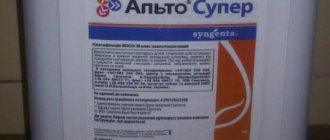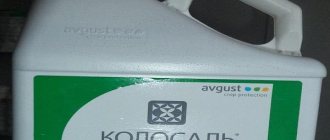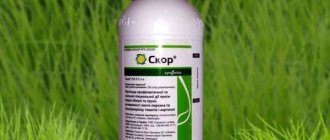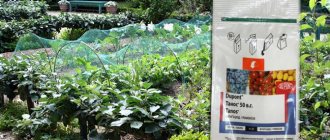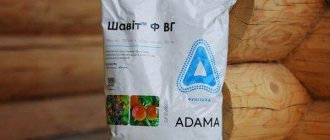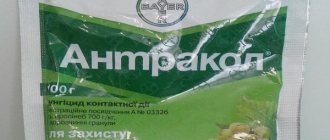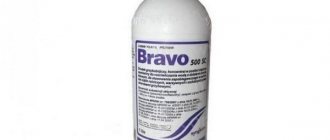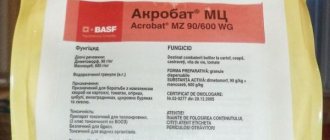Mechanism of action of Prosaro
The fungicide Prozaro contains two active substances belonging to the triazole group - prothioconazole and tebuconazole. After the drug penetrates the plant, both active components inhibit the biosynthesis of sterols, which leads to disruption of the cell walls of the fungus.
Fungicide Shirlan
Fungicide Merpan
The combination of active ingredients promotes:
- long-term supply of active substances to plants and pathogen cells;
- uniform distribution of active ingredients throughout all parts of plants;
- effective against many types of pathogens.
Instructions for use of fungicide
Spraying of crops is carried out during their growing season. Grain crops and rapeseed are processed 1-2 times per season. The first treatment of grain crops is carried out during the appearance of the flag leaf - the beginning of heading. To prevent crops from heading fusarium, spraying is recommended to be carried out at the end of heading - the beginning of flowering.
Spraying of rapeseed is carried out twice: when the first signs of a fungal disease appear, and again - during the period when the plant stretches its stems - the beginning of the formation of pods in the lower tier. The second spraying should be carried out no less than 1.5-2 weeks later.
The consumption of fungicide working fluid for processing grain crops and rapeseed is 200-300 l/ha.
Corn plantings are processed only once per season. Spraying is carried out either as a preventative measure or at the first signs of illness. Working fluid consumption is 300-400 l/ha.
Application technology, timing and consumption
The fungicide is used for spraying grain crops. Treatment of any plant is carried out during the growing season. The drug is effective against various types of rust, fusarium, rot, spots, mold, etc.
It is recommended to carry out processing in calm, windless weather.
- For wheat: from 0.8 to 1 liter per hectare for fusarium head blight, and from 0.6 to 0.8 liter per hectare for other diseases. In this case, the period of spraying for fusarium should be at the end of the heading phase and the beginning of flowering. In other cases, spraying is carried out in the flag leaf phase before heading.
- For barley: from 0.6 to 0.8 liters per hectare of area. Apply at the flag leaf stage before heading.
- For rapeseed: from 0.6 to 0.8 liters per hectare. Spraying begins when the first symptoms appear - from the moment the stem begins to stretch until the pods appear.
- For corn: in case of mold damage to the cobs or the appearance of blister smut, the application rate is 1 liter per hectare. In other cases, from 0.8 to 1 liter per hectare. Treatment is carried out during the growing season for preventive purposes and when symptoms of a crop disease are detected.
Rules for preparing the working solution and how to use it
The fungicide is a concentrate for the preparation of aqueous dilution. To make a working solution, the required amount of emulsion is first dissolved in 1/3 of the total volume of water. After thorough stirring, add the remaining water.
The resulting solution is used for spraying plantings. The instructions for use determine the optimal period of work - the growing season. Repeated processing of wheat, barley, rapeseed is carried out at the beginning of heading, corn - at the stage of cob formation.
Storage period and conditions
Prosaro should be stored in a well-ventilated and fairly dry place. The drug should be hidden from direct sunlight and should also be in a place inaccessible to children. When stored in original packaging, the shelf life of Prozaro is 2 years.
Fungicide "Prozaro" is an excellent choice for carrying out therapeutic and preventive measures in your areas. Its wide range of effects and high efficiency in the fight against many diseases will allow you to preserve the entire crop without harming it.
Precautionary measures
The drug Prosaro has a hazard class 2 for humans and a hazard class 3 for bees. When interacting with the solution, adhere to safety rules.
Before starting work, put on rubber gloves and a respirator. The solution is used within 24 hours after preparation. During treatment, animals and people without protective equipment are removed from the area. Spraying is carried out away from water bodies.
Spraying is carried out in dry, cloudy weather. You can choose morning or evening.
Important! When working with the solution, do not allow it to come into contact with open areas of the body. In case of direct contact, the drug is washed off with clean water.
If the solution gets inside, you need to drink several glasses of clean water and activated carbon in the amount of 1 g per 1 kg of body weight. Be sure to see a doctor.
The drug Prosaro is stored in a dry place, inaccessible to animals and children. The storage period is no more than 2 years from the date of production.
Fungicide Prosaro (BAYER)
Protects without fail
Two-component systemic fungicide with preventive and therapeutic effects
for winter and spring grain crops, winter and spring rapeseed
Advantages
- Wide range of controlled diseases.
- Exceptional effectiveness against fusarium head blight.
- Reducing the content of mycotoxins in grain.
- The presence of both preventive and therapeutic effects.
- High efficiency even when treating symptoms of diseases.
- Rapid onset of action and subsequent long-term protection.
- Modern high performance formulation.
Preparative form
Emulsion concentrate containing 125 g/l prothioconazole and 125 g/l tebuconazole.
Mechanism of action
Both active substances belong to the group of triazoles (prothioconazole is a new subgroup of triazolinthiones) and inhibit the biosynthesis of sterols, disrupting the integrity of the cell walls of pathogens.
Activity spectrum
Wheat:
rust species (Puccinia spp.), septoria leaf and ear blight (Septoria spp.), pyrenophora (Drechslera triticirepentis), powdery mildew (Blumeria graminis), dark brown spot (Bipolaris sorokiniana), fusarium ear blight (Fusarium spp.)
PROSARO, KE
Purpose
Systemic fungicide with preventive, curative and eradicating action for grains and legumes, rapeseed, sugar beets and corn.
Advantages
- Reliable control of key leaf and ear diseases
- Exceptional effectiveness against fusarium and septoria head blight
- Guaranteed reduction of mycotoxins in grain
- Therapeutic and preventive effects against cercospora and powdery mildew
- Increases yield, sugar content of beets and sugar yield per hectare
- Fast initial action followed by long lasting protection
- Pronounced greening effect
- Significant improvement in grain quality of malting barley and wheat
- Growth-regulating effect in autumn
- Reliable control of autumn diseases (Phomosis, Alternaria, root rot)
- Highly effective against sclerotinia and alternaria
Chemical class
prothioconazole – triazolinthiones tebuconazole – triazoles
Mechanism of action
Systemic fungicide with protective and therapeutic action, with a pronounced effect of growth regulation (for winter rape). The combination of prothioconazole and tebuconazole provides a “biphasic effect.” Tebuconazole provides a rapid initial effect (“stop effect”). Prothioconazole penetrates the plant more slowly than tebuconazole and is distributed internally. Provides long-lasting protective effect.
Prothioconazole has a stimulating effect on the process of photosynthesis - a “greening effect”. This is a new class of d.v. with a similar physiological effect.
The drug increases the stability of ear filling under conditions of elevated air temperatures.
Activity spectrum
Fusarium, septoria and helminthosporium head blight, septoria leaf blight, powdery mildew, rust (species), net spot, rhynchosporium.
Impact speed
Fast initial activity from the moment of treatment.
Period of protective action
Depending on weather conditions, the degree of damage to the crop, the intensity of the disease and the dose of the drug, the period of protective action can range from 3 to 5 weeks. The effect increases in the case of preventive treatment or with a minimal degree of damage (less than 2% of development). The effect is reduced with significant damage to the crop or under conditions of epiphytotic development.
Features of application
The drug can be used for both preventive and therapeutic purposes.
It is a highly effective fungicide against leaf diseases at a consumption rate of 0.6-0.8 l/ha.
However, the drug shows the highest biological and economic effectiveness when used in the “earing – beginning of flowering” phase to combat ear diseases (fusarium, septoria, etc.) at a consumption rate of 0.8-1.0 l/ha.
On malting barley it provides high efficiency, especially in conditions of epiphytotic development of ear diseases (warm and humid weather), improves the quality of malting barley grain. Crops of malting barley treated with the fungicide Prosaro®, along with an increase in yield, are practically not susceptible to cracking of the grain shell during ripening and harvesting in high humidity conditions. The quality indicators required for delivering grain for brewing are significantly increased: color improves, grain size, viability and germination energy increase.
When sown with food wheat, the grain size and the weight of 1000 grains increase, and the color of the grain improves.
In autumn. When there is a threat of overgrowth of winter rapeseed, it is used as a growth regulator to improve overwintering and as a fungicide against root rot, phomosis, and alternaria. The optimal processing time is the 4-6 leaf phase of rapeseed.
In the spring. For effective protection against sclerotinia, Prosaro® is used at a rate of 0.6-0.8 l/ha from the yellow bud phase to the end of flowering. The optimal period for using the drug is in the full flowering phase, when about 50% of the flowers have faded and the first petals have begun to fall. For maximum effectiveness against Alternaria, treatment should be carried out in the “mid-end of flowering” phase. Prosaro® also has a positive effect on the uniformity of ripening and reduces the risk of premature cracking of the pods.
To protect lupine from anthracnose, it is necessary to apply fungicides twice. The first treatment is preventive (subject to humid and warm weather), the second treatment is carried out 7-14 days after the first treatment. Depending on the planned protective measures, Prosaro® can be used to protect lupine from anthracnose from the phase of “two pairs of true leaves” to the “end of flowering” in single and double fungicidal protection systems.
Features of application on beets
The drug can be used for both preventive and therapeutic purposes.
Efficiency of Prozaro®, % of control (according to the Republican Unitary Enterprise "Experimental Scientific Station for Sugar Beet", 2009-2014)
Efficacy of Prozaro® against cercospora (photo September 23, 2011), Republican Unitary Enterprise “Experimental Scientific Station for Sugar Beet”
Safety for bees
At recommended application rates, Prosaro® is non-toxic to bees and other pollinating insects. When treating during the flowering period for pest control, it is recommended to mix it with the bee-safe insecticide Biscaya®.
Selectivity (phytotoxicity)
At recommended application rates, the drug is not phytotoxic to the treated crops.
Compatibility
Compatible with most pesticides and mineral fertilizers. However, in each specific case, a preliminary check for chemical compatibility is necessary.
Shelf life and storage conditions
At least 2 years from the date of manufacture at temperatures from -10 °C to +35 °C.
Prosaro® has a therapeutic effect against fusarium head blight!
Control (without processing)
2 days after treatment with Prosaro®
Prosaro® reduces the content of mycotoxins by 6-8 times!
“Greening effect”
of Prozaro® on winter triticale, SEC “Progress-Vertelishki”, 2010
